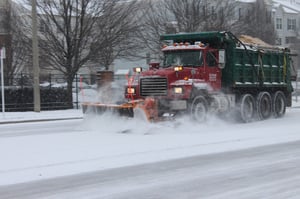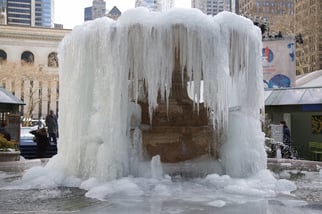 Freezing temperatures can shut down much of a city, even in the most prepared areas. But even in the worst weather, the need for sewer maintenance remains high. While a storm rages above ground, effluent continues flowing and pipes continue degrading. So how do crews keep moving during storms? Prioritize.
Freezing temperatures can shut down much of a city, even in the most prepared areas. But even in the worst weather, the need for sewer maintenance remains high. While a storm rages above ground, effluent continues flowing and pipes continue degrading. So how do crews keep moving during storms? Prioritize.
When cold weather hits, you need to know what to do: what needs to happen and who is responsible? Pump stations must be checked regularly; blockages still need to be cleared. But when a storm first hits, public works must have its priorities in order to ensure work gets done and employees stay safe.
Many cities have combined public works departments where a teams do anything and everything: water, sewer, roads, landscaping and public space maintenance, signal and signage maintenance, and more. So when a major snowstorm hits, these communities know that certain things take priority. Plowing major arterial roads and highways, then plowing access to vital facilities like hospitals, police stations, fires stations, pump stations, and other municipal facilities take priority. Spraying deicer or salting the roads in the case of ice also takes priority.
If you’re lucky enough to have a separate water and wastewater department, then tasks take a slightly different path. Instead of doing the plowing, your team must wait until the road crew does the plowing first.
 Either way, your crew must then continue working through the cold. As the temperature drops, whether you have no snow or two feet of snow, the work becomes more challenging. Condensation becomes a huge problem. Equipment going from freezing trucks and freezing outdoors to warm, humid manholes and pipes fog quickly, making it difficult or even impossible to see. Operators may have to place fans in upstream manholes to improve visibility or abandon inspections altogether.
Either way, your crew must then continue working through the cold. As the temperature drops, whether you have no snow or two feet of snow, the work becomes more challenging. Condensation becomes a huge problem. Equipment going from freezing trucks and freezing outdoors to warm, humid manholes and pipes fog quickly, making it difficult or even impossible to see. Operators may have to place fans in upstream manholes to improve visibility or abandon inspections altogether.
Freezing water also becomes a problem. Water freezes locks shut; water freezes manhole lids; it all makes the work harder. Workers get tired faster and have to work slower, putting a damper on progress. When the temperature drops, it’s important to adjust your expectations to match. You may check your pump stations every day, but when two feet of snow comes down, that frequency may not be possible. Employees may be diverted to other tasks; some may not be able to make it to the shop.
Having a clear understanding of what tasks take top priority during cold weather ensures that when the snow clears and temperatures rise, dealing with the aftermath will be minimal and your crew is safe to return to work as usual.
While you wait for the snow to clear, request a demo of our Rehab Planning Module which simplifies planning and budgeting your rehabilitation activities.
Snow plow picture courtesy of Kit Case via Flickr (CC BY-SA 2.0)
Fountain picture courtesy of Tina Leggio via Flickr (CC BY-ND 2.0)





